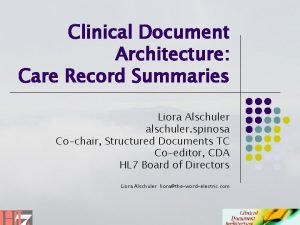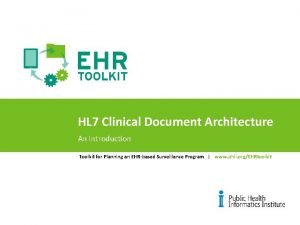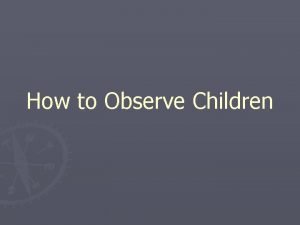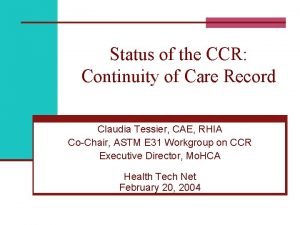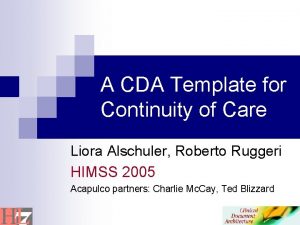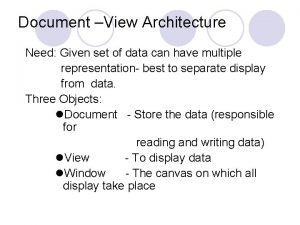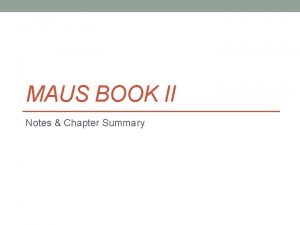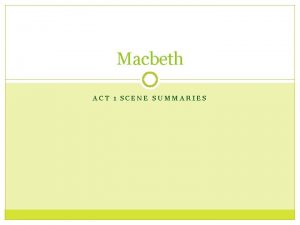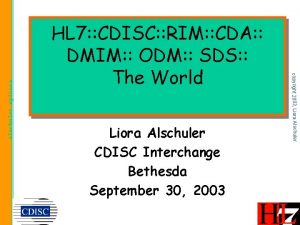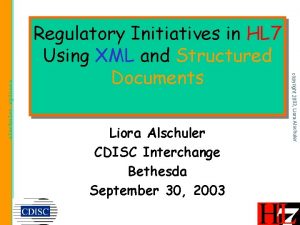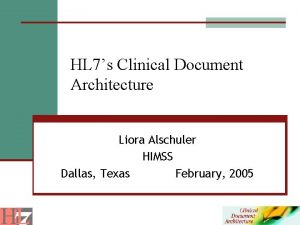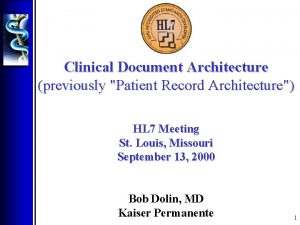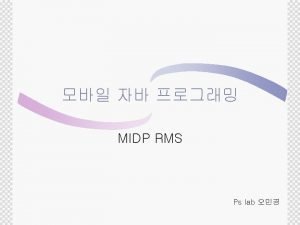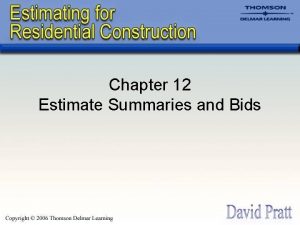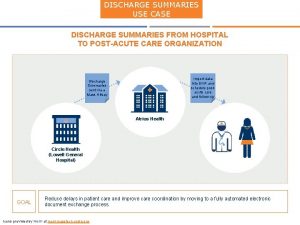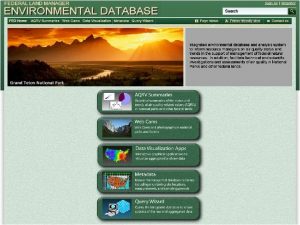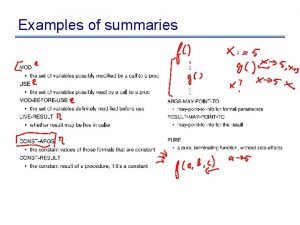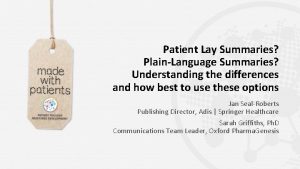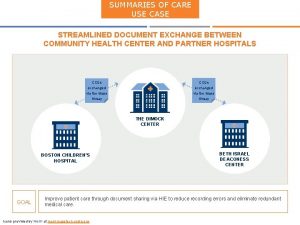Clinical Document Architecture Care Record Summaries Liora Alschuler






















- Slides: 22

Clinical Document Architecture: Care Record Summaries Liora Alschuler alschuler. spinosa Co-chair, Structured Documents TC Co-editor, CDA HL 7 Board of Directors Liora Alschuler liora@the-word-electric. com

Health Level Seven (HL 7. org) l l Standards Development Organization Developing standards for interoperability l l l l Patient care Public health Clinical trials Reimbursement HIPAA DSMO 20 years, 2000 members 26 international affiliates “A model community”: building standards to a single information model

CDA l l l Clinical Document Architecture ANSI/HL 7 CDA R 1. 0 -2000 CDA R 2. 0 to be published shortly created & maintained by HL 7 Structured Documents Technical Committee (SDTC) A specification for document exchange using l l XML, the HL 7 Reference Information Model (RIM) Version 3 methodology and vocabulary (SNOMED, ICD, local, …)

CDA: A Document Exchange Specification l l l l This is a CDA and this and this

CDA Release 2: Text + Observation <Section> <code="10153 -2" code. System="LOINC“> Past Medical History </code> <text>Patiënt met een voorgeschiedenis astma en hoge bloeddruk. Nu opgenomen in het ziekenhuis met een osteoartritis, rechter knie </text> <component 1> <context. Conduction. Ind value="TRUE"/> <Observation class. Code=“COND”> <code=”G-1001” code. System=”SNOMED” display. Name=”Prior dx”/> <value code=”D 1 -201 A 8” code. System=”SNOMED” display. Name=”Osteoarthritis”> <original. Text><reference value=”#a 3”/></original. Text> </value> <target. Site. Code code=”T-15720” code. System=”SNOMED” display. Name=”knee”> <qualifier> <name code=”G-C 220” code. System=”SNOMED” display. Name=”with laterality”/> <value code=”G-A 100” code. System=”SNOMED” display. Name=”right”/> </qualifier> </target. Site. Code> </Observation> </component 1> </Section>


CDA l l Widely implemented outside the US l most common application is transfer of care (Germany, Greece, Finland, Japan, Korea, Canada, Argentina) l CDA transfer of care pilot in British Columbia (see CDA Implementation Guide for Vancouver Island Health Authority on SDTC web page) In the US l CDA considered for HIPAA Claims Attachments (as payload in X 12 message) l Mayo: ramping up to 50, 000 notes/week: investment in information as capital asset l Columbia-Presbyterian: text and fielded data entry with natural language processing and controlled vocabulary l Tricare Management Activity (Do. D TMA) will implement CDA attachments supporting referrals management

CDA l Specification is generic l l l Human-readable “narrative block” l l Any document type Any clinical content Defines legal content Displays with simple style sheet Required Machine-readable “clinical statements” l l l Drives automated extraction, decision support…. Uses HL 7 RIM, controlled vocabulary Optional

CDA Body: Human-readable l l l paragraph list table caption required link content revise (delete/insert) subscript/superscript special characters (e. g. , symbols, Greek letters) in Unicode emphasis line break render. Multi. Media (non-XML graphics, video…)

CDA Body: Machine Processible l Clinical statement l l l l l Observation Procedure Organizer Supply Encounter Substance Administration Observation Media Region Of Interest Act Optional

Creating CDA Document Types l l Add constraints to generic specification Designed for a community of users l l l Can be further specialized for closer communities l l Scope: US Clinical applications: transfer of care Scope: Massachusetts Clinical application: pediatric Document coded to requirements of the document type Still valid against generic schema and specification

Validating CDA document types. x. Path, . xsl, prose CRS Schematron. xsd. xml <Section code=Plan> XPath validation of Implementation Guide requirements Validates against generic schema

CDA & Incremental Semantic Interoperability l l Patients transfer between providers with vastly different IT capabilities Need to support information requirements at point of care l l Full EMR adoption… not predictable based on past adoption curves Assume gradually rising, but still heterogeneous levels of sophistication l l Data formats (imaging, text, XML) Coded data (metadata, basic structure, simple results reporting, complex clinical statements)

CDA & Incremental Semantic Interoperability l Level 1: standardizes just the metadata (header) required for management l l Query, retrieve, file, track Full clinical content, but no coding requirements Target authoring: any (including imaging, fax) Level 2: Level 1 + standard structures (section, list, table titles) l l l Clinical domain-specific Supports basic extraction, summary Target authoring: dictation, electronic text with template or minimal consistent structure

CDA & Incremental Semantic Interoperability l l l Level 1: just the metadata (header) Level 2: Level 1 + structures Level 3: Level 2 + clinical statements (coded for machine processing) l l Expressive to full extent of Reference Information Model and vocabulary Target authoring: EMR, forms entry, natural language processing Many actual levels between these benchmarks A document can always exceed the required level of encoding

Clinical content invariant, regardless of level Level 1: XML, no codes Level 1: non-XML body Level 2: XML, section codes

Let’s take a look…

Implementation Guides constrain coding Identical required section coding l l Not presentation Not narrative style Different optional narrative coding Two styles of presentation, one Implementation Guide

Implementation Guides constrain coding l l l Not presentation Not narrative style Can impose uniform presentation, style l l l but just for presentation the coding drives machine processing Distinction becomes more significant with Level 3

Current ballots & more… 1 3 4 2

Care Record Summary Implementation Guides for CDA Release 2 April 13, 2005 Keith W. Boone keith. boone@dictaphone. com Dictaphone Corporation Clinical Language Understanding

Thank you! Questions?
 Liora alschuler
Liora alschuler Consolidated clinical document architecture
Consolidated clinical document architecture Hip fracture clinical care standard
Hip fracture clinical care standard Specimen record observation
Specimen record observation Levels of care primary secondary tertiary
Levels of care primary secondary tertiary Document.setcookie
Document.setcookie Continuity of care record
Continuity of care record Dr charlotte lemech
Dr charlotte lemech Continuity of care document template
Continuity of care document template Document view architecture
Document view architecture What is an objective summary
What is an objective summary Eric walters wave
Eric walters wave Chapter 12-15 to kill a mockingbird
Chapter 12-15 to kill a mockingbird Tkam chapter 1-5 summary
Tkam chapter 1-5 summary Their eyes were watching god summary chapter 1
Their eyes were watching god summary chapter 1 Summary of act 3 of the crucible
Summary of act 3 of the crucible Samenvatting noughts and crosses
Samenvatting noughts and crosses Red kayak characters
Red kayak characters Lost horizon chapter summaries
Lost horizon chapter summaries Maus part 2 chapter 3 summary
Maus part 2 chapter 3 summary Frankenstein chapters 3-5
Frankenstein chapters 3-5 Macbeth chapter summary
Macbeth chapter summary Macbeth act 1 and 2 summary
Macbeth act 1 and 2 summary
